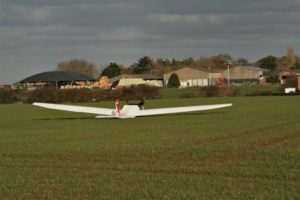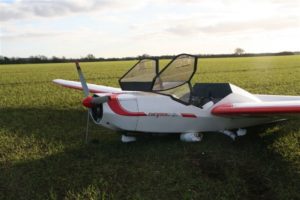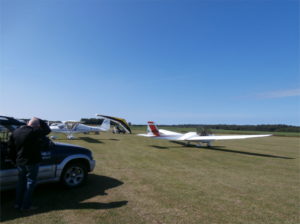Long time Monoposto member Patrick Huston has written an article, not about racing, but about other adrenaline fueled pursuits for your enjoyment:
Dear Editor,
Long ago I decided that the last place I wanted engine failure was at 150’ when climbing away from 08 at Strubby. This altitude put me at the end of the runway with houses ahead, hangars to the right, and an industrial complex full of heavy machinery to the left, so it was inevitable that Dr Sod’s Law determined that this was where the engine failed. What I had not envisaged was that Dr Sod’s Law dictated that the second seat be occupied by my wife Ruth.
With no altitude or speed to play with, the recommended course of action is to land ahead, but the engine was still turning, and it sounded as if the exhaust pipes had detached from the manifolds, something that has happened before, being a two stroke this results in a considerable drop in
power, but provides enough power to maintain level flight, so I turned to conform with the left hand circuit expecting to fly a low circuit and return to the airfield. As the turn was executed I realised that there was effectively zero power, and we did not have the range to reach a runway.
I instantly became aware of why one should not turn back in such a situation, with no speed or momentum, turning out of the 8kt headwind reduces airflow over the wings. In sailing terminology the apparent wind was reduced. The crosswind leg was minimal, another high risk turn followed as we turned downwind. So far so good, we had not stalled, but a house roof and a garden with medium sized trees lay ahead, with minimal clearance we avoided them. Fully occupied I did not look down expecting the wheels to bump on the house’s ridge tiles, but my wife did and started
screaming………….
We were now down to about 50’ but there were no more large obstacles, just hedges, ditches, and posts marking field boundaries. In theory I could now turn into wind, but doubted that we had sufficient height, especially as there was no longer sufficient altitude to bank, but while we were still
flying I gave it a go, and to my amazement the Chevvron responded, straightening up being determined by stopping the turn just before the wheels touched, we landed with the wings level, and in line with the rows of winter wheat.
Ruth stopped screaming and commented that that was another of her nine lives gone. Unfortunately, it was a very soggy field of winter wheat, and instead of rolling the wheels dug straight in, when the spats touched they immediately tore off the Chevvron’s notoriously weak undercarriage.
Photographs prove that the Chevvron came to a halt in about half a metre, but our ground speed was so low that no unusual force was experienced by the crew, and pitch was minimal, but still enough to remove the nose wheel. Neither my wife or I commented on any discomfort experienced in the landing, instead the comments were about how close the ground was, and how muddy we were going to get walking out of the field and recovering a wheelless aircraft. The stall speed of a Chevvron is about 30mph, it did not slide, I have the photographs to prove that it did not slide, but we did not experience sudden deceleration.
I will never be able to explain how such a landing occurred. After some time for reflection Ruth suggested that it had been a good landing, and did not add the caveat: “In the circumstances”. The ground was so soft that the propeller survived intact even though the mud on one of the blades indicated that it had been embedded in about 30cm of soil. The propeller drive belt sheared, it was eventually found on a runway 150 metres distant. Damage was restricted to a couple of dings and scrapes on the underside of the forward fuselage from the sheared off nosewheel, broken undercarriage, torn off brake pipes, and an engine that had suffered a mechanical failure, probably one of the crankshaft bearings broke up, a SD570 weakness that I thought cured. The engine was not seized, but was most reluctant to revolve. Most disappointing, for over 200hrs I have been used to the Konig SD570 purring quietly away. This instantaneous failure came out of the blue, the engine had been running well, zero time rebuilds are a required at 300hrs and it had 280hrs recorded*.
I will be eternally grateful to the Strubby club members who left their Sunday dinners and other activities to recover the wheelless Chevvron into its bespoke trailer. Getting the wheelless fuselage into the trailer without doing further damage was a challenge. My wife and I took off at 1300hrs, were in a pub ‘enjoying’ a late Sunday lunch with post mortem at
1600hrs………. A busy three hours. The Chevvron was repairable, but I was in the middle of selling my house and moving to Huddersfield. With nowhere to keep an aircraft near my new home the Chevvron was sold, it went abroad.
The Chevvron is a composite microlight of motor glider configuration designed by John Wright of Gem fame, I was very sorry to part with it. And given the above experience I have only praise for its flying qualities.
The Police had been called, before we left the flying club a police officer stood behind me talking to a club member. I overheard the police officer say, “He seems very calm for someone who has just crashed”. The club member replied, “He races single seaters”.
Patrick Huston
* 280hrs before major mechanical failure may sound reasonable to some, but compared to the reliability of a modern car engine it is pathetic. 280hrs @ 60mph (its a Chevvron) equates to 16800 miles. One expects any modern car engine to cover at least 100000 miles with no problems. And the Zetec in my track car has covered about 15000 miles on track, flogged every inch of the way while the Konig was always treated with great consideration. No wonder the literature for microlight engines is peppered with disclaimers.




